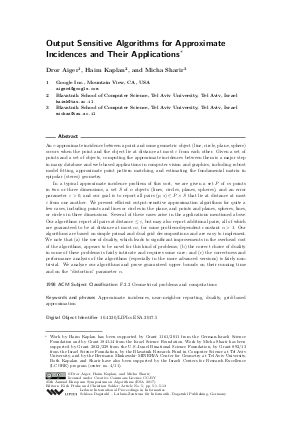Output Sensitive Algorithms for Approximate Incidences and Their Applications
Authors Dror Aiger, Haim Kaplan, Micha Sharir
-
Part of:
Volume:
25th Annual European Symposium on Algorithms (ESA 2017)
Part of: Series: Leibniz International Proceedings in Informatics (LIPIcs)
Part of: Conference: European Symposium on Algorithms (ESA) - License:
 Creative Commons Attribution 3.0 Unported license
Creative Commons Attribution 3.0 Unported license
- Publication Date: 2017-09-01
File

PDF
LIPIcs.ESA.2017.5.pdf
- Filesize: 0.56 MB
- 13 pages
Document Identifiers
Subject Classification
Keywords
- Approximate incidences
- near-neighbor reporting
- duality
- grid-based approximation
Metrics
- Access Statistics
-
Total Accesses (updated on a weekly basis)
0Document
0Metadata
Abstract
An epsilon-approximate incidence between a point and some geometric object (line, circle, plane, sphere) occurs when the point and the object lie at distance at most epsilon from each other. Given a set of points and a set of objects, computing the approximate incidences between them is a major step in many database and web-based applications in computer vision and graphics, including robust model fitting, approximate point pattern matching, and estimating the fundamental matrix in epipolar (stereo) geometry. In a typical approximate incidence problem of this sort, we are given a set P of m points in two or three dimensions, a set S of n objects (lines, circles, planes, spheres), and an error parameter epsilon>0, and our goal is to report all pairs (p,s) in P times S that lie at distance at most epsilon from one another. We present efficient output-sensitive approximation algorithms for quite a few cases, including points and lines or circles in the plane, and points and planes, spheres, lines, or circles in three dimensions. Several of these cases arise in the applications mentioned above. Our algorithms report all pairs at distance <= epsilon, but may also report additional pairs, all of which are guaranteed to be at distance at most alphaepsilon, for some constant alpha>1. Our algorithms are based on simple primal and dual grid decompositions and are easy to implement. We note though that (a) the use of duality, which leads to significant improvements in the overhead cost of the algorithms, appears to be novel for this kind of problems; (b) the correct choice of duality in some of these problems is fairly intricate and requires some care; and (c) the correctness and performance analysis of the algorithms (especially in the more advanced versions) is fairly non-trivial. We analyze our algorithms and prove guaranteed upper bounds on their running time and on the "distortion" parameter alpha. We also briefly describe the motivating applications, and show how they can effectively exploit our solutions. The superior theoretical bounds on the performance of our algorithms, and their simplicity, make them indeed ideal tools for these applications. In a series of preliminary experimentations (not included in this abstract), we substantiate this feeling, and show that our algorithms lead in practice to significant improved performance of the aforementioned applications.
Cite As Get BibTex
Dror Aiger, Haim Kaplan, and Micha Sharir. Output Sensitive Algorithms for Approximate Incidences and Their Applications. In 25th Annual European Symposium on Algorithms (ESA 2017). Leibniz International Proceedings in Informatics (LIPIcs), Volume 87, pp. 5:1-5:13, Schloss Dagstuhl – Leibniz-Zentrum für Informatik (2017)
https://doi.org/10.4230/LIPIcs.ESA.2017.5
BibTex
@InProceedings{aiger_et_al:LIPIcs.ESA.2017.5,
author = {Aiger, Dror and Kaplan, Haim and Sharir, Micha},
title = {{Output Sensitive Algorithms for Approximate Incidences and Their Applications}},
booktitle = {25th Annual European Symposium on Algorithms (ESA 2017)},
pages = {5:1--5:13},
series = {Leibniz International Proceedings in Informatics (LIPIcs)},
ISBN = {978-3-95977-049-1},
ISSN = {1868-8969},
year = {2017},
volume = {87},
editor = {Pruhs, Kirk and Sohler, Christian},
publisher = {Schloss Dagstuhl -- Leibniz-Zentrum f{\"u}r Informatik},
address = {Dagstuhl, Germany},
URL = {https://drops.dagstuhl.de/entities/document/10.4230/LIPIcs.ESA.2017.5},
URN = {urn:nbn:de:0030-drops-78224},
doi = {10.4230/LIPIcs.ESA.2017.5},
annote = {Keywords: Approximate incidences, near-neighbor reporting, duality, grid-based approximation}
}
Author Details
References
-
P. K. Agarwal and J. Erickson. Geometric range searching and its relatives. In B. Chazelle, J. E. Goodman, and R. Pollack, editors, Advances in Discrete and Computational Geometry, Contemp. Math. 223, Amer. Math. Soc. Press, Providence, RI, pages 1-56, 1999.

-
D. Aiger and K. Kedem. Approximate input sensitive algorithms for point pattern matching. Pattern Recognition, 43(1):153-159, 2010.

-
D. Aiger, N. J. Mitra, and D. Cohen-Or. 4-points congruent sets for robust pairwise surface registration. ACM Trans. Graphics, 27(3):Article 85, 2008.

-
P. Brass. Combinatorial geometry problems in pattern recognition. Discrete Comput. Geom., 28(4):495-510, 2002.

-
O. Chum and J. Matas. Optimal randomized RANSAC. IEEE Trans. Pattern Anal. Mach. Intell., 30(8):1472-1482, 2008.

-
IEEE Int’l Workshop "25 Years of RANSAC" in conjunction with CVPR'06 (RANSAC25'06). IEEE Computer Society, 2006.

-
G. D. da Fonseca and D. M. Mount. Approximate range searching: The absolute model. Comput. Geom. Theory Appls., 43(4):434-444, 2010.

-
J. Erickson. New lower bounds for Hopcroft’s problem. Discrete Comput. Geom., 16(4):389-418, 1996.

-
M. A. Fischler and R. C. Bolles. Random sample consensus: A paradigm for model fitting with applications to image analysis and automated cartography. Commun. ACM, 24(6):381-395, 1982.

-
M. Gavrilov, P. Indyk, R. Motwani, and S. Venkatasubramanian. Combinatorial and experimental methods for approximate point pattern matching. Algorithmica, 38(1):59-90, 2003.

-
P. J. Heffernan and S. Schirra. Approximate decision algorithms for point set congruence. Comput. Geom. Theory Appls., 1(4):137-156, 1994.

-
D. P. Huttenlocher and S. Ullman. Recognizing solid objects by alignment with an image. Internat. J. Computer Vision, 5(2):195-212, 1990.

-
P. Indyk, R. Motwani, and S. Venkatasubramanian. Geometric matching under noise: Combinatorial bounds and algorithms. Proc. 10th ACM-SIAM Sympos. Discrete Algorithms, pages 457-465, 1994.

-
N. Mellado, D. Aiger, and N. J. Mitra. Super 4pcs: fast global pointcloud registration via smart indexing. Comput. Graphics Forum, 33(5):205-215, 2014.

